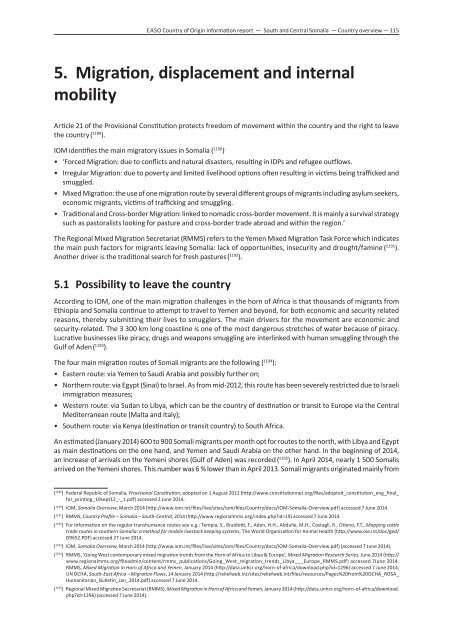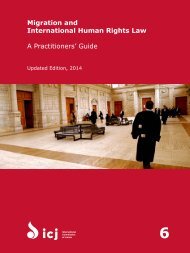Create successful ePaper yourself
Turn your PDF publications into a flip-book with our unique Google optimized e-Paper software.
EASO Country of Origin Information report — South and Central <strong>Somalia</strong> — Country overview — 115<br />
5. Migration, displacement and internal<br />
mobility<br />
Article 21 of the Provisional Constitution protects freedom of movement within the country and the right to leave<br />
the country ( 1189 ).<br />
IOM identifies the main migratory issues in <strong>Somalia</strong> ( 1190 ) :<br />
• ‘Forced Migration: due to conflicts and natural disasters, resulting in IDPs and refugee outflows.<br />
• Irregular Migration: due to poverty and limited livelihood options often resulting in victims being trafficked and<br />
smuggled.<br />
• Mixed Migration: the use of one migration route by several different groups of migrants including asylum seekers,<br />
economic migrants, victims of trafficking and smuggling.<br />
• Traditional and Cross‐border Migration: linked to nomadic cross‐border movement. It is mainly a survival strategy<br />
such as pastoralists looking for pasture and cross‐border trade abroad and within the region.’<br />
The Regional Mixed Migration Secretariat (RMMS) refers to the Yemen Mixed Migration Task Force which indicates<br />
the main push factors for migrants leaving <strong>Somalia</strong>: lack of opportunities, insecurity and drought/famine ( 1191 ).<br />
Another driver is the traditional search for fresh pastures ( 1192 ).<br />
5.1 Possibility to leave the country<br />
According to IOM, one of the main migration challenges in the horn of Africa is that thousands of migrants from<br />
Ethiopia and <strong>Somalia</strong> continue to attempt to travel to Yemen and beyond, for both economic and security related<br />
reasons, thereby submitting their lives to smugglers. The main drivers for the movement are economic and<br />
security‐related. The 3 300 km long coastline is one of the most dangerous stretches of water because of piracy.<br />
Lucrative businesses like piracy, drugs and weapons smuggling are interlinked with human smuggling through the<br />
Gulf of Aden ( 1193 ).<br />
The four main migration routes of Somali migrants are the following ( 1194 ):<br />
• Eastern route: via Yemen to Saudi Arabia and possibly further on;<br />
• Northern route: via Egypt (Sinai) to Israel. As from mid-2012, this route has been severely restricted due to Israeli<br />
immigration measures;<br />
• Western route: via Sudan to Libya, which can be the country of destination or transit to Europe via the Central<br />
Mediterranean route (Malta and Italy);<br />
• Southern route: via Kenya (destination or transit country) to South Africa.<br />
An estimated (January 2014) 600 to 900 Somali migrants per month opt for routes to the north, with Libya and Egypt<br />
as main destinations on the one hand, and Yemen and Saudi Arabia on the other hand. In the beginning of 2014,<br />
an increase of arrivals on the Yemeni shores (Gulf of Aden) was recorded ( 1195 ). In April 2014, nearly 1 500 Somalis<br />
arrived on the Yemeni shores. This number was 6 % lower than in April 2013. Somali migrants originated mainly from<br />
( 1189 ) Federal Republic of <strong>Somalia</strong>, Provisional Constitution, adopted on 1 August 2012 (http://www.constitutionnet.org/files/adopted_constitution_eng_final_<br />
for_printing_19sept12_-_1.pdf) accessed 2 June 2014.<br />
( 1190 ) IOM, <strong>Somalia</strong> Overview, March 2014 (http://www.iom.int/files/live/sites/iom/files/Country/docs/IOM‐<strong>Somalia</strong>‐Overview.pdf) accessed 7 June 2014.<br />
( 1191 ) RMMS, Country Profile – <strong>Somalia</strong> – South‐Central, 2014 (http://www.regionalmms.org/index.phpid=19) accessed 7 June 2014.<br />
( 1192 ) For Information on the regular transhumance routes see e.g.: Tempia, S., Braidotti, F., Aden, H.H., Abdulle, M.H., Costagli, R., Otieno, F.T., Mapping cattle<br />
trade routes in southern <strong>Somalia</strong>: a method for mobile livestock keeping systems, The World Organisation for Animal Health (http://www.oie.int/doc/ged/<br />
D9652.PDF) accessed 27 June 2014.<br />
( 1193 ) IOM, <strong>Somalia</strong> Overview, March 2014 (http://www.iom.int/files/live/sites/iom/files/Country/docs/IOM‐<strong>Somalia</strong>‐Overview.pdf) (accessed 7 June 2014).<br />
( 1194 ) RMMS, ‘Going West contemporary mixed migration trends from the Horn of Africa to Libya & Europe’, Mixed Migration Research Series, June 2014 (http://<br />
www.regionalmms.org/fileadmin/content/rmms_publications/Going_West_migration_trends_Libya___Europe_RMMS.pdf) accessed 7June 2014.<br />
RMMS, Mixed Migration in Horn of Africa and Yemen, January 2014 (http://data.unhcr.org/horn‐of‐africa/download.phpid=1296) accessed 7 June 2014;<br />
UN OCHA, South‐East Africa – Migration Flows, 14 January 2014 (http://reliefweb.int/sites/reliefweb.int/files/resources/Pages%20from%20OCHA_ROSA_<br />
Humanitarian_Bulletin_Jan_2014.pdf) accessed 7 June 2014.<br />
( 1195 ) Regional Mixed Migration Secretariat (RMMS), Mixed Migration in Horn of Africa and Yemen, January 2014 (http://data.unhcr.org/horn‐of‐africa/download.<br />
phpid=1296) (accessed 7 June 2014).



